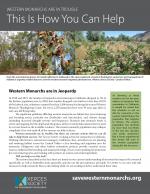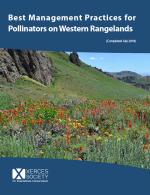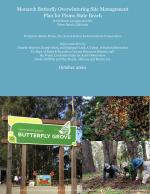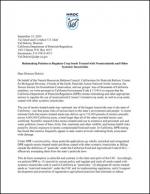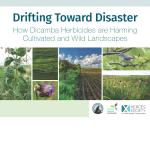As a science-based organization, the Xerces Society produces dozens of publications annually, all of which employ the best available research to guide effective conservation efforts. Our publications range from guidelines for land managers, to brochures offering overviews of key concepts related to invertebrate conservation, from books about supporting pollinators in farmland, to region-specific plant lists. We hope that whatever you are seeking—whether it's guidance on making a home or community garden pollinator-friendly, advice on developing a local pesticide reduction strategy, or detailed information on restoring habitat—you will find it here!
Find Publications
Use the search functions to sort by publication type (books, guidelines, fact sheets, etc.), location, and/or subject (agriculture, gardens, pollinators, pesticides, etc.).
In 2018 and 2019, the number of monarchs overwintering in California dropped to 1% of the historic population size. In 2020, that number dropped even further to less than 0.01% of the historic size, volunteers counted less than 2,000 monarchs during the annual Western Monarch Thanksgiving Count. For every 2,250 monarchs there were 30 years ago, there is only one left flying today.
To help land managers incorporate pollinator-friendly practices into rangeland management, the Xerces Society for Invertebrate Conservation developed Best Management Practices for Pollinators on Western Rangelands. These guidelines were developed for federally managed rangelands that span the eleven western United States: Arizona, California, Colorado, Idaho, Montana, New Mexico, Nevada, Utah, Oregon, Washington, and Wyoming.
North Beach Campground Site, Pismo Beach, California
Pismo State Beach butterfly grove has been ranked as the most important out of more than 100 California overwintering sites. To help ensure that Pismo Beach continues to provide high quality habitat for monarchs, this site management plan offers recommended actions to support overwintering monarchs in both the short and long term.
Essays on Invertebrate Conservation
Forests and woodlands are valued worldwide for their environmental benefits and economic products. In this issue we explore three very different forest environments and the insects they support: old-growth coniferous forests in the Pacific Northwest, eastern broadleaf forests in New Jersey, and ancient woodlands in England.
The Center for Biological Diversity and the Xerces Society for Invertebrate Conservation filed a petition seeking Endangered Species Act protection for the imperiled Siuslaw hairy-necked tiger beetle.
Guidelines for Creating & Managing Habitat for Dragonflies and Damselflies
These guidelines provide information for homeowners and other landowners about the creation, management, and maintenance of backyard ponds to attract native wildlife, with an emphasis on attracting dragonflies and damselflies. By creating aquatic resources for dragonflies and damselflies in their own backyards, homeowners will be rewarded by views of visiting wildlife and will realize the ecological benefits of creating essential aquatic habitat that may be lacking or degraded in many urban landscapes.
The Xerces Society joined a group of environmental and health organizations to petition the California Department of Pesticide Regulation to regulate the planting of crop seeds coated with systemic insecticides. California's pesticide regulatory system has a loophole that allows for unchecked use of insecticide-coated seed on farms throughout the state. Neonicotinoid insecticides are commonly used as seed coatings, resulting in significant contamination of California's waterways and ecosystems as they move off-field.
Ongoing Management of Pollinator Habitat
High quality pollinator meadows sometimes experience a decline in wildflower diversity or abundance as they age. This guide provides recommendations on how to bring declining meadows back into a high quality condition.
Guidelines for Protecting Fireflies in the United States and Canada
Fireflies are some of our most celebrated insects. They have immense cultural, biological, and economic importance and are important components of natural ecosystems. Their public appeal also makes them ideal flagship species for conservation. They are found all over the world, on every continent except Antarctica, living in temperate and tropical areas. More than two thousand species have been described, with nearly 170 in the United States and Canada.
How Dicamba Herbicides are Harming Cultivated and Wild Landscapes
More than five million acres of crops, an area roughly the size of New Jersey, have been injured by the herbicide dicamba since the U.S. EPA conditionally registered three new formulations for in-crop applications in dicamba-resistant soybeans and cotton in 2016. Damage from this highly mobile herbicide does not stop at the field edge: dicamba drift places tens of millions of acres of wild and ornamental plants—and the wildlife these plants support—at risk.

